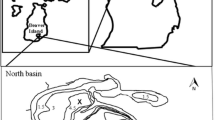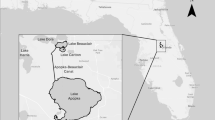Abstract
Long-term water quality monitoring data from two riverine lakes in the Upper Mississippi River basin, Lakes St. Croix and Pepin, were analyzed to compare the long-term average water quality conditions and land use distributions, water quality trends and loads at lake inlets and outlets, trends from long-term versus short-term monitoring records, and the ability of paleolimnological cores to accurately infer lake water quality conditions. During the 1976–2004 period, the long-term average concentrations of nutrients, suspended solids, and chlorophyll-a were consistently lower at the Lake St. Croix inlet versus the Lake Pepin inlet, which drains a greater proportion of urban and agricultural runoff. Despite these differences, nutrient trends were similar at the inlets to both lakes; reductions in total phosphorus and ammonium concentrations were attributed to improvements in point source technologies, whereas increasing nitrate concentrations were attributed to both point source changes and nonpoint source increases. Despite improvements in several water quality variables, nitrate concentrations are increasing in both lakes, sediment trends indicate persistent nonpoint source inputs to Lake Pepin, and current total phosphorus concentrations remain well above pre-1950s levels in both lakes. Since urban development and agriculture are increasing in the Lake St. Croix and Lake Pepin Watersheds, continued point source regulation and additional nonpoint source control efforts will be needed to further improve water quality in these lakes. The 1976–2004 trends for most water quality variables were similar at inlet versus outlet sites on Lake St. Croix. Trends at Lake Pepin inlet versus outlet sites were less similar, but data availability limited the comparison to the 1993–2003 period. While the truncated data record highlighted short-term trends in both lakes, the full data record was most useful for exploring general patterns in water quality. Length of monitoring record affected our ability to detect trends at the inlets to both lakes, and altered the magnitude of detected trends. During the two decades of the 1980s and 1990s, paleolimnological estimates of retained phosphorus loads were similar to those estimated from recent water quality monitoring. These similarities support the use of paleolimnological approaches to infer past water quality conditions in Lakes St. Croix and Pepin.





Similar content being viewed by others
References
Alexander RB, Smith RA, Schwarz GE, Boyer EW, Nolan JV, Brakebill JW (2007) Differences in phosphorus and nitrogen delivery to the Gulf of Mexico from the Mississippi River Basin. Environ Sci Technol 42:822–830. doi:10.1021/es0716103
Andrews WJ, Fallon JD, Kroening SE, Lee KE, Stark JR (1996) Water quality assessment of part of the Upper Mississippi River Basin, Minnesota and Wisconsin—review of selected literature. Water-Resources Investigations Report 96-4149, U.S. Geological Survey, Mounds View, Minnesota
Blumentritt DJ, Wright HE Jr, Stefanova V (this issue) Formation and early history of lakes Pepin and St. Croix of the Upper Mississippi River. J Paleolimnol. doi:10.1007/s10933-008-9291-6
Davis PJ (2004) St. Croix Basin phosphorus-based water quality goals. Report on the recommended water quality goals of the St. Croix Basin Water Resources Planning Team and the proceedings of the 5th annual conference “Protecting the St. Croix: reducing and managing nutrients and sediments”. Available at: www.pca.state.mn.us/water/basins/stcroix/index.html
Edlund MB, Engstrom DR, Triplett LD, Lafrancois BM, Leavitt PR (this issue-a) Twentieth century eutrophication of the St. Croix River (Minnesota-Wisconsin, USA) reconstructed from the sediments of its natural impoundment. J Paleolimnol. doi:10.1007/s10933-008-9296-1
Edlund MB, Triplett LD, Tomasek MD, Bartilson K (this issue-b) From paleo to policy: partitioning the historical point and nonpoint phosphorus loads to the St. Croix River, Minnesota-Wisconsin, USA. J Paleolimnol. doi:10.1007/s10933-008-9288-1
Engstrom DR, Almendinger JE, Wollin JA (this issue) Historical changes in sediment and phosphorus loading to the Upper Mississippi River: mass-balance reconstructions from the sediments of Lake Pepin. J Paleolimnol. doi:10.1007/s10933-008-9292-5
Eyster-Smith NM, Wright HE Jr, Cushing EJ (1991) Pollen studies at Lake St. Croix, a river lake on the Minnesota/Wisconsin border, USA. Holocene 1:102–111. doi:10.1177/095968369100100202
Goolsby DA, Battaglin WA, Aulenbach BT, Hooper RP (2001) Nitrogen input to the Gulf of Mexico. J Environ Qual 30:329–336
Harcum JB, Loftis JC, Ward RC (1992) Selecting trend tests for water quality series with serial correlation and missing values. Water Resour Bull 28:469–478
Heiskary S, Vavricka M (1993) Mississippi River phosphorus study, Sect. 3. Description of the study area-Lake Pepin water quality, 1976–1991. Water Quality Division, Minnesota Pollution Control Agency, St. Paul, Minnesota 103 pp
Helsel DR, Hirsch RM (1992) Statistical methods in water resources. Elsevier Science Publishers, Amsterdam, Netherlands
Hirsch RM, Alexander RB, Smith RA (1991) Selection of methods for the detection and estimation of trends in water quality. Water Resour Res 27:803–813. doi:10.1029/91WR00259
Houser JN (2005) Multiyear synthesis of limnological data from 1993 to 2001 for the Long Term Resource Monitoring Program. LTRMP Technical Report 2005-T0003. U.S. Geological Survey, Upper Midwest Environmental Sciences Center, La Crosse, Wisconsin
Jarvie HP, Neal C, Withers PJA (2006) Sewage-effluent phosphorus: a greater risk to river eutrophication than agricultural phosphorus? Sci Total Environ 360:246–253. doi:10.1016/j.scitotenv.2005.08.038
Kloiber S (2004) Regional progress in water quality: analysis of water quality data from 1976–2002 for the major rivers in the Twin Cities. Regional report number 32-04-045. Metropolitan Council Environmental Services, St. Paul, Minnesota
Kroening SE, Andrews WJ (1997) Water quality assessment of part of the Upper Mississippi River Basin, Minnesota and Wisconsin—nitrogen and phosphorus in streams, streambed sediment and ground water, 1971–94. Water-Resources Investigations Report 97–4107. U.S. Geological Survey, Mounds View, Minnesota
Larson CE, Johnson DK, Flood RJ, Meyer ML, O’Dea TJ, Schellhaass SM (2002) Lake Pepin phosphorus study, 1994–1998: effects of phosphorus loads on water quality of the Upper Mississippi River, Lock and Dam No. 1 through Lake Pepin. Metropolitan Council Environmental Services, St. Paul, Minnesota 84 pp
Lenz BN, Robertson DM, Fallon JD, Ferrin R (2003) Nutrient and suspended-sediment concentrations and loads, and benthic invertebrate data for tributaries to the St. Croix River, Wisconsin and Minnesota, 1997–1999. U.S. Geological Survey Water-Resources Investigations Report 01-4162 63 pp
Loftis JC, McBride GB, Ellis JC (1991) Considerations of scale in water quality monitoring and data analysis. Water Resour Bull 27:255–264
Mainstone CP, Parr W (2002) Phosphorus in rivers—ecology and management. Sci Total Environ 282–283:25–47. doi:10.1016/S0048-9697(01)00937-8
McDowell RW, Wilcock RJ (2004) Particulate phosphorus transport within stream flow of an agricultural catchment. J Environ Qual 33:2111–2121
Meyer ML, Schellhaass SM (2002) Sources of phosphorus, chlorophyll, and sediment to the Mississippi River upstream of Lake Pepin: 1976–1996. Final Report by the Metropolitan Council Environmental Services, St. Paul, Minnesota 74 pp
MPCA (2004) Detailed assessment of phosphorus sources to Minnesota watersheds. Minnesota Pollution Control Agency, St. Paul, Minnesota
Mulla DJ, Sekely AC (this issue) Historical trends affecting the accumulation of sediment and phosphorus in Lake Pepin, Upper Mississippi River, USA. J Paleolimnol. doi:10.1007/s10933-008-9293-4
MWCC (1988) Procedures manual: Water Quality Monitoring and Analysis Division. Quality Control Department. Metropolitan Waste Control Commission, St. Paul 414 pp
Nater EA, Kelley DW (1998) Heavy-mineral chemistry of Lake Pepin sediments. Final Research Report to Metropolitan Council Environmental Services, St. Paul, Minnesota
Rabelais NN, Turner RE, Weisman WJ Jr (2001) Hypoxia in the Gulf of Mexico. J Environ Qual 30:320–329
Räike A, Pietiläinen O-P, Rekolainen S, Kauppila P, Pitkänen H, Niemi J, Raateland A, Vuorenmaa J (2003) Trends of phosphorus, nitrogen, and chlorophyll-a concentrations in Finnish rivers and lakes in 1975–2000. Sci Total Environ 310:47–59. doi:10.1016/S0048-9697(02)00622-8
Robertson DM, Lenz BN (2002) Response of the St. Croix River pools, Wisconsin and Minnesota, to various phosphorus loading scenarios. Water Resources Investigations Report 02-4181. U.S. Geological Survey, Middleton, Wisconsin
Senjem N (2004) Lake Pepin watershed TMDL eutrophication and turbidity impairments project overview. Water Quality/Impaired Waters Report #9.01a (Wqiw9-01a). Minnesota Pollution Control Agency, St. Paul, Minnesota
Soballe DM, Fischer JR (2004) Long Term Resource Monitoring Program Procedures: water quality monitoring. U.S. Geological Survey, Upper Midwest Environmental Sciences Center, La Crosse, Wisconsin, March 2004. Technical Report LTRMP 2004-T002-1 (Ref. 95-P002-5) 73 pp. Appendices A-J
Stow CA, Borsuk ME, Stanley DW (2001) Long-term changes in watershed nutrient inputs and riverine exports in the Neuse River, North Carolina. Water Res 35:1489–1499. doi:10.1016/S0043-1354(00)00402-4
Sullivan JF (2000) Long-term water quality trends observed at Wisconsin’s ambient monitoring sites on the Upper Mississippi River. Wisconsin Department of Natural Resources, 48 pp
Triplett LD, Edlund MB, Engstrom DR (this issue) A whole-basin stratigraphic record of sediment and phosphorus loading to the St. Croix River, USA. J Paleolimnol. doi:10.1007/s10933-008-9290-7
Vaché KB, Eilers JM, Santelmann MV (2002) Water quality modeling of alternative agricultural scenarios in the U.S. Corn Belt. J Am Water Resour Assoc 38:773–787. doi:10.1111/j.1752-1688.2002.tb00996.x
Wiener JG, Fremling CR, Korschgen CE, Kenow KP, Kirsch EM, Rogers SJ, Yin Y, Sauer JS (1998) Mississippi River. In: Mac MJ, Opler PA, Puckett Haeker CE, Doran PD (eds) Status and trends of the nation’s biological resources, vol 1. U.S. Geological Survey, Reston, Virginia, pp 351–384
Wright HE Jr, Lease K, Johnson S (1998) Glacial River Warren, Lake Pepin, and the environmental history of southeastern Minnesota. In: Patterson CJ, Wright HE Jr (eds) Contributions to quaternary studies in Minnesota. University of Minnesota, Limnological Research Center, Minneapolis, Minnesota, pp 131–140
Acknowledgments
This work was funded through staff time contributions from the National Park Service Midwest Regional Office, Water Resources Division, St. Croix National Scenic Riverway, and Great Lakes Inventory and Monitoring Network. We are grateful to members of the St. Croix Basin Water Resources Planning Team, Nutrient Technical Subcommittee, for their ongoing support of this project and for their valuable insights and discussion. The helpful comments of John Sullivan, Wisconsin Department of Natural Resources, and an anonymous reviewer greatly improved this manuscript.
Author information
Authors and Affiliations
Corresponding author
Additional information
This is one of eight papers dedicated to the “Recent Environmental History of the Upper Mississippi River” published in this special issue of the Journal of Paleolimnology. D. R. Engstrom served as guest editor of the special issue.
Rights and permissions
About this article
Cite this article
Lafrancois, B.M., Magdalene, S. & Johnson, D.K. Recent water quality trends and a comparison to sediment-core records for two riverine lakes of the Upper Mississippi River basin: Lake St. Croix and Lake Pepin. J Paleolimnol 41, 603–622 (2009). https://doi.org/10.1007/s10933-008-9294-3
Received:
Accepted:
Published:
Issue Date:
DOI: https://doi.org/10.1007/s10933-008-9294-3




